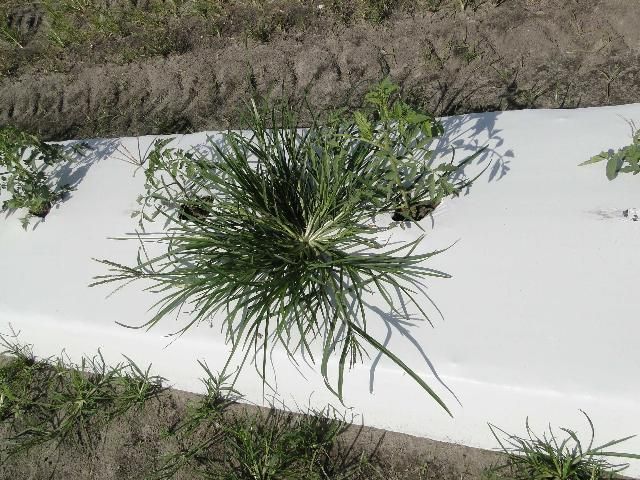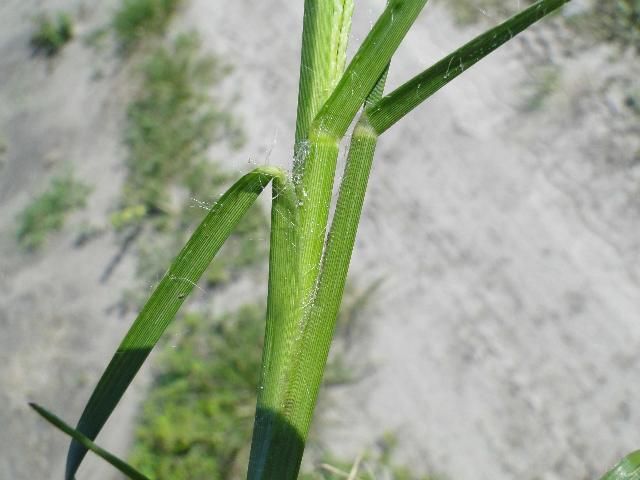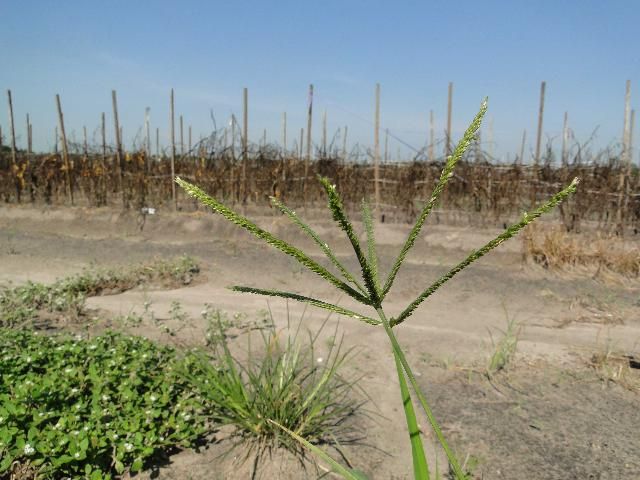Biology and Management of Goosegrass (Eleusine indica (L.) Gaertn.) in Tomato, Pepper, Cucurbits, and Strawberry1

Credit: Nathan S. Boyd, UF/IFAS
Species Description
Class
Monocotyledonous plant
Family
Poaceae (grass family)
Other Common Names
Indian goosegrass, wiregrass, crowfootgrass
Life Span
Summer annual but may survive as a short-lived perennial in tropical areas.
Habitat
Terrestrial habitat. Commonly distributed in cultivated and abandoned fields, open ground, gardens, lawns, road sides, and railroad tracks.
Distribution
Occurs throughout most tropical areas and extends substantially into the subtropics, especially in North America where it occurs throughout most of the United States.
Growth Habit
Tufted grass with prostrate or upright growth. Tends to form a low-growing rosette with outward radiating stems that have white colored leaf sheaths at the base (Figure 2).

Credit: Nathan S. Boyd, UF/IFAS
Seedling
The first leaf that emerges extends about 1 cm in length and lies parallel to the soil. The ligule is membranous and fringed. The leaf sheath is broad and tends to be white in color. The leaves are folded (flattened) with no hairs.
Shoot
The stems are flattened and branching with few to no hairs along the edges and are fleshy at the base. Stems tend to be prostrate but can grow erect. The base of the stem is whitish or pale-green in color (Figures 2 and 3). The leaves can be up to one foot long and generally hairless but may be slightly pubescent (hairs present) at the base. Leaves are laterally flattened or folded (Figure 3). A short-toothed membranous ligule is present.

Credit: Nathan S. Boyd, UF/IFAS
Roots
Fibrous root system
Inflorescence
The inflorescence is composed of 2–13 flattened, shiny, finger-like spikes that emerge from a common point. Each spike is composed of two rows of sessile spikelets (Figure 4). In Florida, the plant typically has 4–6 spikes with one or two spikes attached below the terminal cluster. The spike resembles a goosefoot, hence the name.

Credit: Nathan S. Boyd, UF/IFAS
Fruit and Seeds
The fruit are tiny, reddish brown, one-seeded, and enclosed in a thin covering. Seed production reports vary significantly with some authors reporting 140,000 seeds per plant (Chin 1979).
Similar Species
Goosegrass is closely related to E. coracana (African finger millet). Goosegrass superficially resembles crabgrasses (Digitaria spp.) because of the finger-like spikes of its inflorescence and its growth habit, but it is actually quite different than crabgrass. The foliage of goosegrass is shiny compared to the dull-colored foliage of crabgrass. The finger-like spikes of crabgrass are narrower than those of goosegrass and are usually green or reddish-green and less shiny.
Plant Biology
Goosegrass is a common annual turf and horticultural weed found throughout Florida. It grows well in compact, wet soils and competes successfully with warm-season and cool-season turf grasses, especially with thin, open disturbed turf. It is considered an invasive weed due to its vigorous growth and abundant seed production. Seeds germinate near the surface of moist soils with temperatures above 65°F (Chauhan and Johnson 2008). Seed germination completely ceases if seeds are buried deeper than 3 inches (Chauhan and Johnson 2008; Odero et al. 2013). Persistence in the field is due to abundant seed production and tolerance to close mowing. Goosegrass can grow up to 3 feet tall (Uva et al. 1997) and spreads by reseeding itself.
Management
Physical and Cultural Control
In plasticulture production systems, goosegrass can be controlled with the use of plastic mulches and hand pulling of small plants that emerge in the planting holes during the cropping period. Do not leave plants to reproduce after the removal of the polyethylene mulch because they can replenish the seed bank, which will result in future problems. Fallow period management plays a critical role in population reduction over time. Cultivation, or herbicides in combination with cultivation, can be used to remove goosegrass shoots before they produce seeds. A dense, vigorous cover crop will also inhibit goosegrass emergence and seed production.
Chemical Control
There are several preemergence and postemergence herbicides with activity on goosegrass. For more detailed information about herbicide use please see the most recent version of the Vegetable Production Handbook for Florida (2021–2022), available online at https://edis.ifas.ufl.edu/publication/cv292.
Preemergence
Tomato and Pepper
Napropamide (Devrinol®) and S-metolachlor (Dual Magnum®) are registered for use under plastic mulch and will provide good control of goosegrass. EPTC (Eptam®) may also be used under low density plastic mulches. For row middle applications, goosegrass can be controlled with S-metolachlor, pendimethalin (Prowl® H2O), or flumioxazin (Chateau®).
Cucurbits
On bare-ground plantings and in row middles, DCPA (Dacthal® W-75) will provide good control, while the combination of ethalfluralin and clomazone (Strategy®) will provide excellent control. Row middle goosegrass control can also be achieved with flumioxazin or pendimethalin in some cucurbits. There is currently no product registered for application under the polyethylene mulch that will control goosegrass in cucurbits.
Strawberry
Napropamide and flumioxazin are registered for use under the plastic mulch and will provide good goosegrass control. Pendimethalin and flumioxazin are labeled for use in the row middles.
Postemergence
Tomato, Pepper, and Cucurbits
Over the top of the crop and in the row middles, clethodim (SelectMax® and others) and sethoxydim (Poast®) will provide excellent control. Paraquat (Gramoxone Inteon®) can be applied to the row middles with a shielded sprayer but will only provide excellent control of small seedlings. It is important to note that paraquat-resistant goosegrass has been documented in Florida, especially in the Manatee County production areas (Buker et al. 2002).
Strawberry
Over the top of the crop and in the row middles, clethodim will provide excellent control. Glyphosate (Roundup® -type products) can be used in the row middles with a shielded sprayer to provide excellent control of goosegrass.
General Comments
Sethoxydim and clethodim are the most common products for control of goosegrass because both products are registered for use in many crops. When using these herbicides, be sure not to use a crop oil concentrate when weather conditions are hot. Crop oils can burn the foliage of crops and should only be used when foliage is dry and on days with cloud cover to minimize the possibility of damage. SelectMax® can be used with a nonionic surfactant, which will help reduce the possibility of crop injury. Apply sethoxydim and clethodim prior to seedhead emergence or control will be substantially reduced.
References
Buker III, R.S., S. T. Steed, and W. M. Stall 2002. "Confirmation and Control of a Paraquat-Tolerant Goosegrass (Eleusine indica) Biotype." Weed Technology: 16:309–313.
Chauhan, B. S. and D. E. Johnson. 2008. "Germination ecology of goosegrass (Eleusine indica): An important grass weed of rainfed rice." Weed Science 56:699–706.
Chin, H.F. 1979. "Weed seed – a potential source of danger." Pg 115–119 In L. T. Kwee, ed Proceedings of the Plant Protection Seminar. Kuala Lumpur, Malaysia: Malaysian Plant Protection Society.
Odero, D. C., R. Rice, and L. Baucum. 2013. Biology and control of goosegrass in sugarcane. SS-AGR-367. Gainesville: University of Florida Institute of Food and Agricultural Sciences. https://edis.ifas.ufl.edu/publication/sc096
Uva, R. H., J. C. Neil, and J. M. DiTomaso. 1997. Weeds of the Northeast. Ithaca: Cornell University Press.



